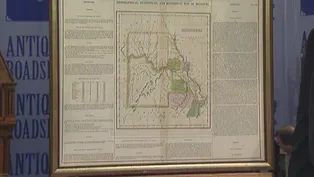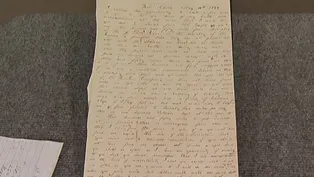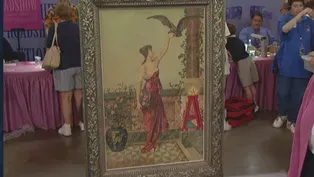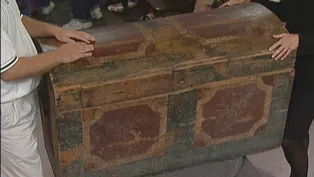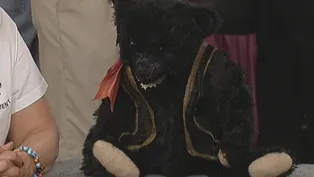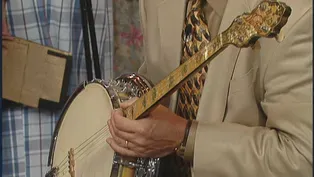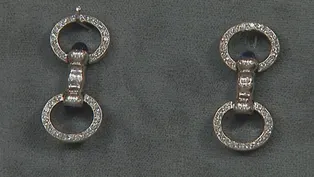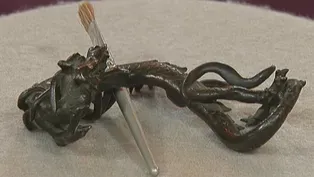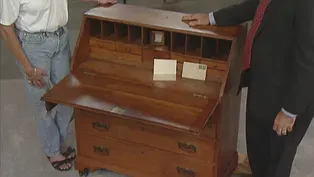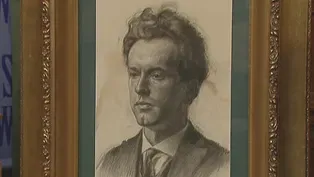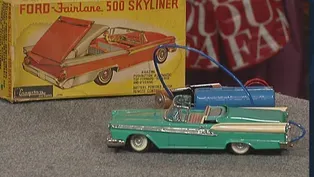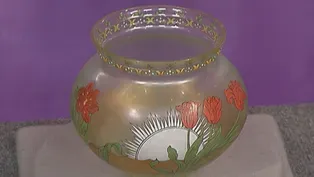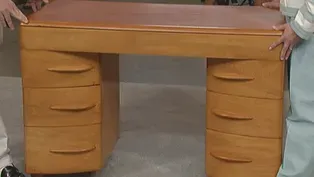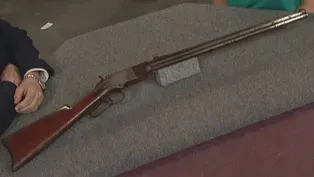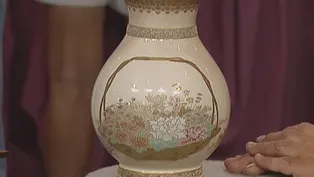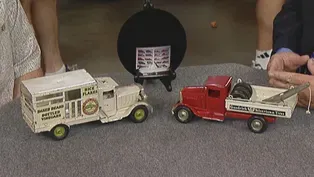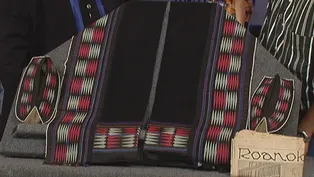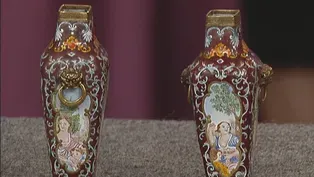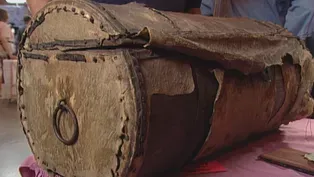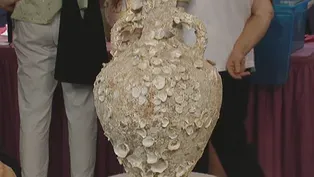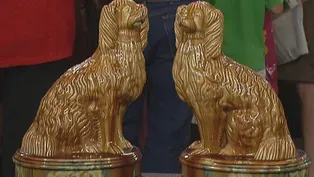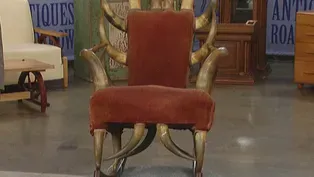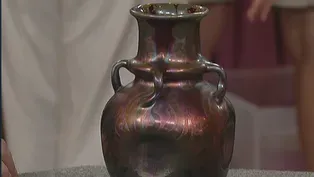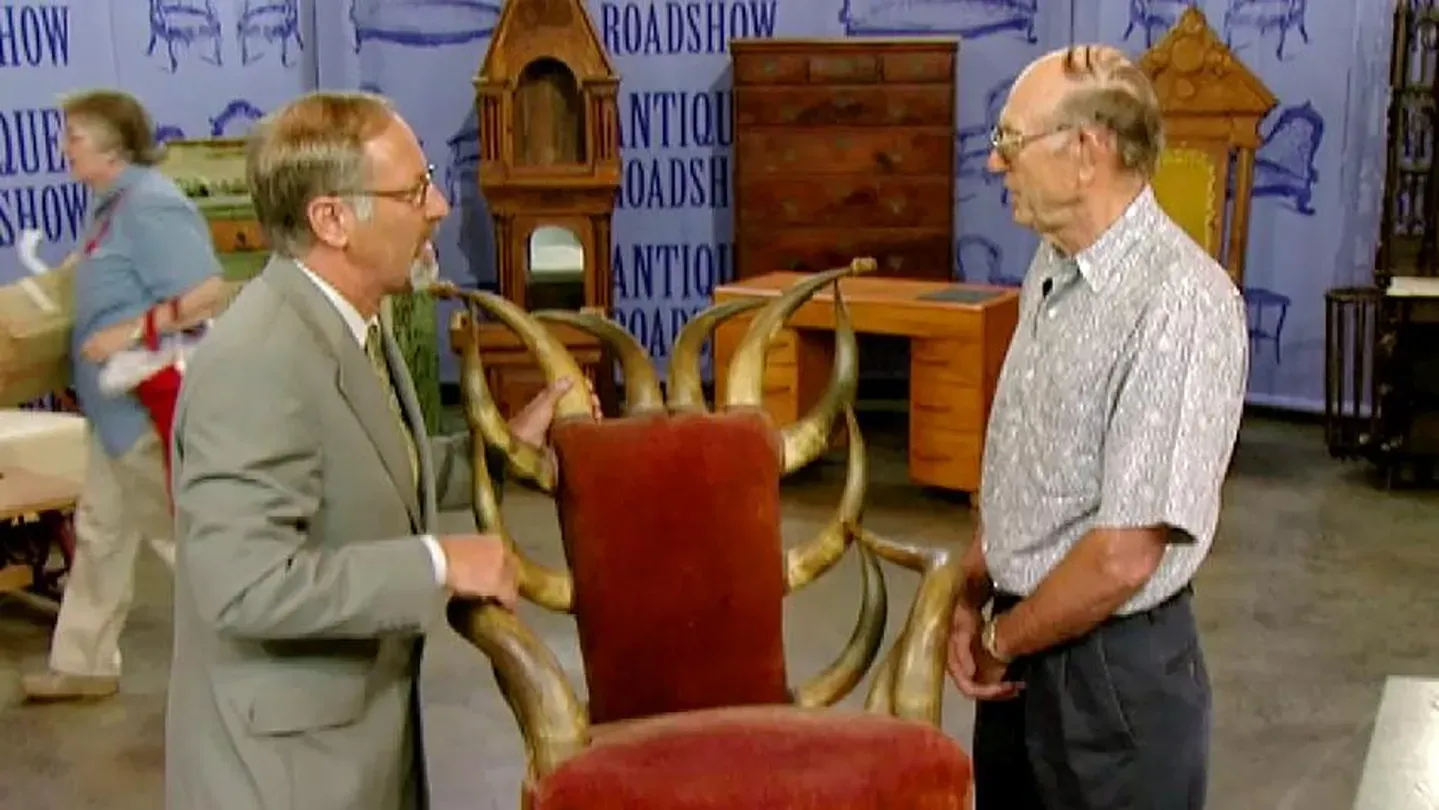

Vintage St. Louis
Season 19 Episode 25 | 53m 7sVideo has Closed Captions
See today's value for items originally appraised 15 years ago, and a $75,000-$100,000 item
See today’s value for items originally appraised 15 years ago. Highlights include an 1847 Petrus van Schendel painting, a Steiff black bear, and an iron framed Henry rifle. Discover which treasure is valued at $75,000-$100,000.
Problems with Closed Captions? Closed Captioning Feedback
Problems with Closed Captions? Closed Captioning Feedback
Funding for ANTIQUES ROADSHOW is provided by Ancestry and American Cruise Lines. Additional funding is provided by public television viewers.

Vintage St. Louis
Season 19 Episode 25 | 53m 7sVideo has Closed Captions
See today’s value for items originally appraised 15 years ago. Highlights include an 1847 Petrus van Schendel painting, a Steiff black bear, and an iron framed Henry rifle. Discover which treasure is valued at $75,000-$100,000.
Problems with Closed Captions? Closed Captioning Feedback
How to Watch Antiques Roadshow
Antiques Roadshow is available to stream on pbs.org and the free PBS App, available on iPhone, Apple TV, Android TV, Android smartphones, Amazon Fire TV, Amazon Fire Tablet, Roku, Samsung Smart TV, and Vizio.
Buy Now

ANTIQUES ROADSHOW 2025 Tour!
Enter now for a chance to win free tickets to ANTIQUES ROADSHOW's 2025 Tour! Plus, see which cities we're headed to!Providing Support for PBS.org
Learn Moreabout PBS online sponsorshipOh my heavens, really?
We're hoping that it's at least 100 years old.
It's 2,000 years old.
Wow, wow.
I went back later, bought it, gave it to her, and she burst into tears.
That was a good result!
Wait, my turn first.
(laughs) Wait.
♪ ♪ MARK WALBERG: Roadshow visited the gateway to the West, St. Louis, in the summer of 2000.
When our gates opened that day, we discovered a wide variety of flea market finds and family heirlooms.
Let's find out if the values of these treasures have gone up, down, or stayed the same in this fresh look at St. Louis.
Well this was from my grandmother's house.
Yes.
And she gave it to me.
I always enjoyed it as a child, I enjoyed looking at the details, but I don't know where she got it.
All right.
This is an artist by the name of Petrus van Schendel.
He was born in Belgium.
This is a beautiful interior, and it's signed and dated down here, 1847.
I value this painting at a minimum of $25,000.
It could go as high as $40,000 to $50,000.
It's a magnificent work, and you're really lucky to have it.
You look surprised.
Well, it's like winning the lottery, as you know.
Yes.
So, at any rate, great painting, you don't wanna... (cries out) (laughs) Wait, wait a minute, my turn first.
(joyful sobbing) Wait, hold it... Take two.
Thank you.
Hold your position, stay that way, please, sir, thank you.
They're gonna put that on tape.
Oh no.
Oh yeah, that's good.
My girlfriend's name is Kerry, and when we were first dating, we were haunting a lot of flea markets and garage sales.
It was a cheap date, and we came across this piece.
A dealer said he'd gotten from an estate sale in Florida, he knew nothing about it.
But my girlfriend is absolutely crazy about Chinese artwork, and dragons in particular.
From the piece, the way it's built, she thought that it rested on the edge of something.
And she found out that since it has a certain number of toes, it's either Chinese or Korean.
APPRAISER: Well, actually, the piece is Chinese.
Well, when it comes to these dragons, you know, the five-clawed dragons are emblems for the imperial house, and that kind of dragon is referred to as lung.
When a dragon has four claws, that's referred to as mang.
And then when a dragon has three claws, or even two claws, they're referred to as jiao.
There were water dragons, sky dragons, earth dragons, you know, all different emblems.
Can you tell what this one is meant to be?
This one would be jiao.
I see.
Yeah, and it didn't hang on anything.
Actually, it say flat like it does there.
And what its original usage was, it was for holding a brush.
For a brush to sit like that to keep the ink from staining the table.
And it's a Chinese scholar's item.
Chinese scholars officials used to consider the most precious objects to be ink sticks, ink stones, and brushes.
But it is Chinese and it's also 18th century.
And, what did you pay for it?
She wanted it more than anything that she's ever wanted in her whole life, but because it was $200, she insisted that we not buy it, and I said I would be happy to get it for her, 'cause it made her so very happy.
Well, she wouldn't hear of it, it was too expensive.
So I went back later, bought it, and gave it to her, and she burst into tears.
That was a good result!
And, yes, it's gotten me a lot of mileage since then.
It's a wonderful object, but in terms of its value, you actually made a good investment.
Not that it's all together that much money, but still an object like this, a conservative estimate at auction, would be like $500 to $700, and I would expect it actually to sell for quite a bit more, because these objects are very, very popular, very desirable, an enormous amount of collectors for these things.
It's been in my family for only about 30 years.
It was given to my grandmother by a gentleman who apparently had an uncle who was a doctor.
Mm-hmm.
And he was going to throw out all the tins and use the box as storage.
This is a student cabinet made by the Parke-Davis company, who's still in business today, probably made around the turn of the century, 1890, 1900.
And it is, going by the list here, little sample tins, and they're handsome little tins like that, of various medical roots, medical herbs, and all kinds of natural remedies, and then there are more in the drawers, correct?
Yep.
So we have a whole drawer there, and then this drawer's full, and even this drawer... My goodness, look at all that.
They get bigger as they go down.
And it's a graduated set.
Well, my gut feeling is telling me this was probably in a medical school as opposed to a student.
This was probably kept in the classroom or in the laboratory, and the fact that it survived is amazing.
I've seen these tins from time to time at flea markets, in boxes, in medical bags, and they're worth, on their own, five dollars, ten dollars, $20 each, depends upon the condition.
I've never seen-- how many of them?
288.
All in very good condition with a few exceptions, and they're mostly full, aren't they?
Except for three.
Except for three, and what ones are missing, do you remember?
I don't know of the other two, but I know that one was cannabis sativa, which my older brother got to.
Your brother got to the cannabis, we won't go there.
They smell beautiful, I feel like I'm in an exotic spice shop.
Now the important thing, what's it worth?
It's impossible to say, but because it's complete, excellent condition, I would give a rough guess-timate of $5,000 to $7,000 for the whole kit and caboodle.
Cool.
Great thing to find in the trash.
Yes!
Donna, I understand that when you acquired this console set, it caused a little bit of stress in your family, tell me about that.
Just a minor bit of stress.
We had just had our third baby.
Mm-hmm.
Had very little money, and were going to purchase curtains for our house, and my husband had told me that morning, before he went to this auction, that we didn't have any money for the curtains.
Went to the auction, said he wasn't gonna buy anything, and then came back with these three bowls.
And when was that?
That was 22 years ago in 1978.
And so what did he pay for these three bowls?
$195.
Well, $195 is not a small amount of money now, and back then it was a lot more money than it is now.
So what did you do when he brought them home?
I sat up the whole night rocking the baby, crying, just knowing that we were probably never going to get out of debt.
And instead, we had three bowls.
Well, the appear to be from the Spanish-American War.
It started as the result of some political unrest in Cuba, which happened in 1895, and the war really took place, primarily, just in 1898.
Mm-hmm.
All of them have pictures of men, and the one that you have there on the front is Teddy Roosevelt.
Teddy Roosevelt at that point was a official in the U.S. government, and he helped organize a group of volunteers for this war called the Rough Riders.
And as a result of that, he became a very important political figure, and later became governor of New York, then vice president, and then president when President McKinley was assassinated in 1901.
If we look at the right hand side of the bowl there, a scene of the assault on San Juan Hill, which is a famous event.
Everything on all this porcelain is completely and totally hand painted.
Let's look at the marks on the bottom.
This porcelain was made by the William Guérin Company in Limoges, France, around the turn of the century, about when all these events happened.
Right.
However, I feel that this set was probably hand-painted in the United States by a very accomplished artist.
This was not an amateur hobbyist who was painting these things, because it was so well done.
Also because it's so detailed.
I think he was probably looking at photographs, or prints, of the war.
Here we have a sunken battleship, and that is probably the battleship Maine, which was sunk in the Havana Harbor, and there was a big patriotic cry at the time, "Remember the Maine."
There were all kinds of commemorative things made about the battleship Maine having been sunk and the injustice done to the American people.
Important things happened because of the war.
Not only was Roosevelt later became president, but we acquired Hawaii as the result of this war, and Guam.
This set is so unusual, I have lots of questions.
Who painted this, why did they paint it, who was it painted for?
And we don't know.
Because we don't know a lot about it, we have to guess at the price, but we feel confident, at an auction, that this set would bring between $10,000 and $20,000.
Wow.
Worth a lot more than those curtains would be worth now, if you got new curtains instead.
He will just be thrilled, I'm thrilled.
It's a great set, thanks very much.
Oh, thank you.
So, Andy, you've brought us some toys made in St. Louis.
Yes, I did, they were my father's toys.
The company that made them, MetalCraft, was here in north St. Louis, and my father lived on the same street as the factory, and he was interested in that St. Louis connection, so he started collecting everything MetalCraft.
It looks like, from the picture, he's got quite a collection.
Yeah.
Well, one of the main reasons they did so well with their trucks is they made them in conjunction with companies as promotional things, like the Heinz pickle company, and Goodrich Silvertown Tires.
It was like an early kind of tie-in.
Okay.
The other thing I always like about them, is the ones that have the headlights.
Yeah, and I think this, it works.
I think you put a battery in here and it'll turn the headlights on.
Some of the most obscure ones are some of the most valuable ones.
Mm-hmm.
There's one called the Samarkand Ice Cream truck, which has sold for as much as $3,700.
Oh wow.
Because they made short runs for a small company, unlike Heinz, which they would make thousands of, or Goodrich, they might get commissioned to make 200 of a certain truck, and those are the ones that are really prized.
But these are some of the relatively common ones, probably the Heinz pickle truck is the most common.
These both are worth around the $450 to $500 in this kind of condition.
Thank you, thank you very much.
Thanks for coming by.
APPRAISER: What can you tell me about these extraordinary Art Deco cufflinks?
MAN: I've had them for about ten years, and bought them from a friend of mine in St. Louis who used to sell jewelry and I've worn them off and on since that time.
They have registry letters on them, which talks about the patent.
The letters are B-T-S-G-D-G, which is the French patent letters, so this was the first time something like this mechanism was ever made, and I'm going to show the audience the mechanism of how this works.
Folds over, like this, and this is what actually goes through the shirt and then holds the cuffs.
Mm-hmm.
I have seen many examples of these done later, but not by Cartier, in gold, gold filled, even costume jewelry-- everyone copied these.
They're signed Cartier, made in France, and also the French platinum dog's head.
And numbers, 02423, which is a French early numbering system, the zero is important in documenting them.
So you've really got almost like a little Cartier history of cufflinks in these.
They're single-cut diamonds, the blue stones are cabochon sapphires.
They're actually quite nice quality.
How much did you pay for them, do you remember?
I think like $500 when I bought them.
In the market today, at auction, I would estimate them $5,000 to $7,000.
That's great.
What do you think?
Yeah, that sounds good.
WOMAN: It's been in our family for a while.
My father is from Italy, and when he was young he was a fisherman, and this is something that he pulled up on the fishing boat when he was out at sea in the Mediterranean Sea.
How long ago was that?
Around 1960.
Oh good, that's when it was still legal to bring it up.
(chuckling): Yes.
And it's always just been in our family.
It had a lot more shell encrustations on it, but over time, some of them have broken off and chipped off.
Do you have any idea how old it is?
No, that's the whole purpose of bringing it.
Can you make a guess?
Well, we're hoping that it's at least 100 years old.
You can put a zero after that, and a double up the front, it's 2,000 years old.
2,000 years old?
2,000 years old.
This particular type of vase came from Pompeii.
Wow.
In the first century A.D. Oh my gosh!
Yeah, and this is a table amphora, used only on the table, not like the large shipping amphoras for oils and grains.
See that's what we wondered, we wondered if it had oil or wine.
In Pompeii, these were used for a fish sauce called garum.
Really?
This fish sauce was so famous, it was like Mole's barbecue sauce in St. Louis.
Really?
It's very interesting, because this fish sauce was so famous, that they were using it from the first century A.D. all the way up to present day.
This is really a beautiful work of art, 'cause mother nature improved upon the amphora.
The shells, I can tell, are of a Mediterranean type.
And, as I say, this is very, very unusual that it's so well preserved.
And would they have shipped it?
Is that why it ended up on the bottom of the Mediterranean Sea?
It was probably being transported to Sicily.
For the sauce?
Yeah.
Fish sauce?
Mm-hmm, for fish sauce, exactly.
Back in the '60s, I was offered thousands of these from North Africa for five to ten dollars each.
Oh, okay.
Up to the '70s, '80s, they would have sold for $200, $300 for decorative purposes.
Today, it's a decorating craze, and this one is of such great quality, that it conceivably in auction could bring up to $2,000.
Wow, wow!
Wonderful, thank you so much.
Thank you for coming.
MAN: Well, this was my father's banjo, and he gave it to me right before he died.
He played this during the Depression.
He was a construction worker, and he played in an evening dance band in the local area here around the St. Louis area, and had a five-piece band, with a gentleman who turned out to be my uncle.
Oh really, how'd that work out?
My mom and her sister went to hear the evening dance band at one of the local fairs, and lo and behold, she ended up marrying the trumpet player in Dad's band, and of course Mom married my father.
And the name of the band was?
Larry's Rolling Stones.
And then they had on their cart, "They gather no moss."
Oh wow, well apparently they gathered a couple of wives.
They did do that for sure, yes.
This is a very, very unusual model of a Bacon banjo.
They made them out of maple, and they were in Connecticut.
But the thing that makes this so special, is all this simulated pearl work, that actually we call celluloid in the business.
But it's simulated pearl, and it's got the name right here on the top, that makes it easier for us.
Right.
The Sultana.
Right.
Sultana Silver Bell, and "B" and "D" at the top.
And on the back of it, the resonator has got this really nice celluloid, and there's a label right here that says, "Style No.
1, B & D" and it's got where they manufactured it in the United States.
Now when your dad was playing music with this, he was playing in dance bands, and one of the reasons they kept using banjos was because they projected loudly.
Right.
And the advent of the electric guitar caused these to fall out of favor, because obviously an electric guitar was gonna make more noise in a large band than anything else.
Before my father died, he took it down to one of the local music stores and had it appraised, or their best guess, and they thought it was in the $1,000 range.
Mostly, for the parts themselves, just thinking in terms of... Not as an instrument.
Right, yes.
Right, well, fortunately for you, there's a resurgence now in using tenor banjos, and in today's market, with this year and manufacturer, I'm talking late '20s, early 1930s, in the condition that it's in with the case and everything, you probably looking at around $3,500 for this.
Oh, great.
Super!
You wanna play for us?
Sure.
Great.
♪ ♪ I received it about ten years ago as a gift.
I work for an airline here, and being that Lindbergh originally did some of our routes... Mm-hmm.
That's what we thought it might have been.
So you thought that the subject of the portrait was Charles Lindbergh?
Correct.
Do you know anything about the artist, Edmund Tarbell?
Nothing at all.
Well, let me tell you a little bit about the artist first, and then we'll talk about the subject.
Tarbell was a Boston painter who had studied in France and was also a teacher, but in Boston he was best known for painting outdoor scenes with figures as well as interior scenes of his family.
Obviously a portrait like this might have been done as a commission, artists often would paint portraits to raise money or as just routine income.
Tarbell was also a member of what was called the Ten Artists, Ten American Artists, and that included major artists like William Merritt Chase, and Frank Benson.
So, he was really part of a very stellar group of painters.
Now in terms of the actual sitter here, it's often very difficult to tell who a particular person is, and in this case, the value of this object is really going to depend on if it is in fact Lindbergh.
I actually checked with a couple of colleagues, who are familiar from Lindbergh from mostly photographic images, and some of them were a bit skeptical as to whether this is actually Lindbergh.
And the reason being, that the hairline apparently is a bit too receded and his hair is very fly-away.
So, either he was having a bad hair day, or as my colleagues might say, this perhaps is not Lindbergh, because he was very fastidious in the way he presented himself and his hairstyle.
The condition of the charcoal drawing is very well rendered, very lushly done with charcoal.
Tarbell is a well-known artist, his oil paintings can make into the seven figure range, so he's quite desirable.
A charcoal drawing like this of a generic man would be evaluated somewhere in the neighborhood of $3,000 to $5,000.
And if this were a portrait of Lindbergh, we would probably evaluate it in the neighborhood of $15,000 to $25,000.
Wonderful.
So it's well worth doing some research.
Wonderful, thank you.
You're welcome.
WOMAN: It's been in the family for over 200 years that we can document and trace back.
APPRAISER: Well, in fact, you were telling us a little bit about the family history, and then the desk came to you loaded with history, didn't it?
Mm-hmm.
We always look at furniture, the material, the way it was crafted, cherry wood, inlays, and in this particular case, when we saw the desk come in, we saw the feet had been cut off right at the bracket here.
We also saw that the brasses had been replaced.
Right.
And we thought, well, it's not that valuable a piece because of its condition.
But then you started telling us the history, and we'll just open it up here, and, in fact, you have letters from your great-grandmother?
Yes, this would be a great-great-aunt, and she wrote this letter in 1913.
Right, so we have a wonderful document from the turn of the century, just when Americans began to be really interested in their own history.
Right.
They seemed to care about the history of this desk, and these wonderful daguerreotypes for the original Phelps family owners.
It really is a historical document as much as it is a piece of furniture.
What we loved about the desk, however, was the inlay on the side of the desk, these magnificent tulips.
And this is a repair to conjoin the case sides as it began to separate.
I have never seen repair a piece with these magnificent tulips.
Some call them "Dutchmen", and they're often just little hourglass-shaped pieces of wood that people put in, and it secures the piece.
We think the desk might be worth $3,000 to $5,000.
Thank you for bringing it in.
No, thank you.
It was in my mother's basement, I'm not exactly sure how it was passed down.
Would it have belonged to grandparents, possibly?
Probably.
Oh really, uh huh.
Well, it's a fascinating American document.
Now, you know when Missouri became a state of the union, don't you?
Yes, 1821.
Okay, absolutely, and this map was actually printed in 1822, and it was printed by two Philadelphians named Henry Carey and Isaac Lea, and they issued an atlas called A Geographical, Statistical, and Historical Atlas of the World.
And this is their geographical, statistical, and historical map of Missouri.
It was engraved on a copper plate, and you can see the plate mark here, going around, and it was printed in black and white, then it was colored by hand with watercolors.
Then they put it through another press and printed this text.
Now, Carey and Lea were considered political economists, and in a time when a lot of politicians and economists were saying, "The world is falling apart, and everything's going to rack and ruin, and we're going to suffer from overpopulation, and plague, and famine," they were saying, "The United States is the most wonderful place in the world, it's just a great place to live, there's so much extra land."
And they wrote glowing reports.
Of course, the real kicker to this particular map, is that it's one of the earliest maps of Missouri.
Notice it says, "List of Governors" here, and how many governors?
One.
Just the one.
1820.
He was governor of the territory, he was governor of the state at the beginning.
One of the things that one should know about a map like this, is that it was once part of an atlas.
And you can often tell that because there's a center fold here, where the map was folded into a book.
Now, that's why it survived.
It would sell anywhere between $600 and $700 on the antique map market today.
Great!
It's interesting, I had no idea.
WOMAN: It was purchased by my mother about 30-some-odd years ago when we lived in Chicago.
She bought it from a lady across the street who had a garage sale, and I think she paid five dollars for it.
And it's been in her house ever since.
No one's paid much attention to it.
It was made in Bohemia, in a place called Petersdorf.
Petersdorf now is located in Germany, but at the time, Germany and Bohemia had these borders that kept changing around, but this particular part of Bohemia is now in Germany.
The name of the company was called Fritz Heckert, and I didn't even have to turn it over.
I knew that his little initials would be on the bottom of the vase, as would be his chief decorator, whose name was Max Rade.
Okay, that accounts for those initials that we didn't know what they were.
Exactly, exactly, and I'm just gonna show everybody.
See how they look, they're right down here.
What typifies this piece is this beautiful iridized surface and this beautiful enamel decoration, and what you have here is, it's pretty elaborate on this piece.
It is.
You have beautiful tulips in various stages of development, and then this is a typical motif that's used in Eastern European decoration on both pottery and glass.
It's the stylized sunburst.
In today's market, to people from other countries, they would probably pay between $1,500 and $2,000 for this piece of glass.
Oh, really?
Yes.
So I'm glad... Good investment.
It's a great investment!
WOMAN: My daughter and I collect bears, and we used to do doll and bear shows quite a bit, and a lady approached me one day and said that she had bought this bear in England, in an antique shop, and that the gentleman who owned the antique shop told her that someone had made him out of an old coat.
Some of my peers had sent her to me because I love black bears and they knew that, and she said she wanted it to have a really good home, and so we decided, well, sure, it was great, so we gave her all the money we had in that day and we went home with him.
And later we did some research, and I kind of got the idea that he could be a Steiff.
In 1912 when the Titanic sunk, Steiff made black bears for England, and they called them a mourning bear.
Okay.
So I thought perhaps that's what he was, and I sent some pictures to a teddy bear appraiser, took measurements, and she said she definitely knew he was a Steiff.
She was 99% sure.
Right, correct.
Okay, what you have there, Carol, is a wonderful Steiff bear with shoe-button eyes, mohair, felt pads.
I mean quality all the way.
I mean, Steiff bears, when you look at them, they have a look.
They're well formed, they have a hump in the back, as you see on this guy.
Somebody's added the clothes, which are not original.
He's straw-stuffed.
He's sort of listing a little bit with age.
They also, a Steiff characteristic, are the very long arms and the big feet.
There's three different sizes, this being the largest size.
Mm-hmm.
So, you thought it was probably Steiff and he really is Steiff.
You said somebody appraised him for you?
Well, she felt that since he was a Steiff from 1912, she said that she felt maybe around between $10,000 and $15,000.
$10,000 to $15,000 is a lot of money for a bear, and black is the rarest color Steiff made, and, you know, I think...
I don't know, would you sell him for $15,000?
No.
Well, I wouldn't sell him for $15,000, either.
He's more in the range, I would say, in the $20,000, $25,000 to $30,000 range.
Oh, my God.
The last one that was sold at auction, I think it brought $30,000 and it was a little bit smaller, and there's not a lot of them around.
I mean, I know of maybe 20 black bears that are known, so you're quite lucky.
Wonderful.
What did you pay for him again?
$65.
$65, so you did okay.
Oh, my gosh.
WOMAN: I don't know too much about it other than I inherited it from my aunt, because nobody else wanted it in the family.
They thought it was kind of ugly.
And I thought, well, maybe I kind of thought it was pretty.
But anyhow, she had gotten it from a couple that she had given money to and could not pay her back.
She didn't even know if there was any value to it, but she accepted it because the couple could not pay back.
You know it's Weller Pottery, which was made in Zanesville, Ohio, and very quickly, I'm gonna show the mark on the bottom where it says Weller.
Has a very big, bold mark here.
Mm-hmm, mm-hmm.
The interesting thing about this vase, was actually done by a Frenchman named Jacques Sicard, who was employed by Sam Weller, came to Zanesville, Ohio, because he did this particular type of metallic glaze that Sam Weller was very fascinated by.
We've kind of got an amalgamation of cultures here.
The form itself is very English, because Weller also employed an Englishman named Frederick Hurten Rhead, who brought many very interesting English shapes.
And so we've got an American company, an English shape, and a French decorator who did the work on this vase.
It has a sunflower design.
There are recesses, four recesses, and the sunflower design.
That's what I kind of liked about it, that recess was so different...
Very nice, and then the four handles, but one of the keys to Weller, which is important with this vase, is the color.
And you can see the whole spectrum of color on this vase, which is very, very nice.
The age on this piece is roughly 1900 to 1905.
Now, someone appraised this vase a few years ago for you?
Mm-hmm.
And what did they tell you?
A gentleman wanted to buy it from me for $500, the appraiser.
I think that at auction, this piece would easily sell for between $2,500 and $3,500.
Really?
Really.
I was at a small country auction barn.
It was hanging on the wall, and it just glowed.
Was it displayed like this, or were they actually separate?
It actually was separate.
The two figures came from someplace else.
Okay.
Well, Limoges is actually a region of France where they make this type of elaborate, beautifully colored metalwork, and how they make it is they take a copper plaque, and they score it, and then they add what is finely ground glass, and they fire it at a very high temperature, which is what gives it that beautiful sheen and those really wonderful colors.
What we have here is a group of plaques.
Obviously we have the birth of Jesus, and then below we have Saint Luke and Saint John, all done in Limoges enamel.
Originally, this material is made round about the 15th century and earlier, and during the 1800s there was something called the Gothic Revival.
Okay.
And it's when they wanted to reaffirm Gothic principles and beliefs.
And what they would do is they would take old wood and rework it, and actually you see all these little sort of holes in here?
Yes.
Well, those are worm tunnels, and when they reworked the wood, the worm tunnels appear, so we know that this is probably a very old piece of wood that has been reworked to conform to the shape of these very interesting plaques.
Taken from, probably, out of a church.
When they would take the churches down, they would rip out this type of work and basically scrap-heap it when they were renovating it.
You have a tiny little signature right down here that says "A.P.
", and "A.P."
probably doesn't stand for the artist, but more than likely stands for the etching beyond which this was actually copied.
Okay.
So you have a copy of an engraving here, and you probably have copies of engravings down here, but beautifully done, very nice quality for 19th century.
Now, how much did you pay for this?
Total $5.50.
Well, I'd say you did okay, because it's probably worth around $2,500 to $3,000.
Okay, good.
Excellent.
Thank you.
MAN: Well, the letter's been in the family probably since 1849, Chris.
It was passed on to me.
I was interested in it, had it preserved by one of the local archivists.
The date of 1849, of course, is crucial.
I mean, that was the year something was found in the West.
Gold, yes.
Gold.
And this was an event that electrified the nation, and people from all over the eastern part of the country emigrated to the west.
It's signed at the end by M.O.
Whilpher, and up at the top it's dated Fort Childs, May 16th, 1849.
It says, "We started from Saint Joseph.
"We are now 250 miles from that place, "on the Platte River, in the country of the Pawnees, "a powerful tribe.
They are, at present, at war with the Cheyennes."
Further down, he talks about the number of people who were making this journey, too.
"We have passed 114 wagons with ox teams and 50 mule teams, and a multitude innumerable behind us."
And here you get that sense of a big exodus.
"We saw the grave of one man, and three men have died behind us."
"We go from 14 to 22 miles per day.
It is 350 miles to Fort Laramie."
That's Wyoming territory.
Yes, it is.
One of their way stations.
And then he says, "If you don't hear from me for a while, "don't be concerned.
You must remember that I am in the land of uncertainty."
I love that phrase.
He was.
This was a major exploration for him.
"When you write, write two letters, one to Sutter's Fort, the other to San Francisco."
So it's clear from the letter where he was going and what was motivating him to make this arduous and very difficult journey.
And I have to say, as a manuscript specialist, that this is the only letter I've ever encountered in 20 years, written by a participant on an actual wagon train.
Really?
You do see letters written after the fact or before departure and diaries kept during the journey, but this is the only actual letter I've seen written by a participant.
What can an owner do with such a letter?
Well, you've done one very smart thing already.
You've had some very discreet conservation to protect it from damage and weakness at the folds.
You've got it flattened rather than folded up in a small parcel, and as a rarity, written on the actual wagon train heading west across the prairies, I would put a value somewhere in the range of $3,000 to $5,000.
Oh, my God.
Seems like a lot for a letter of someone who's not a historical figure.
Yeah, yeah.
But the content here is really key.
MAN: I believe it was made by Miami Indians of northern Indiana.
The article stated that these were handed down from generation to generation from the Miami Indian chief Little Turtle and his daughter, who was one of the last Indian princesses.
She died in the year of 1899.
The outfit was handed down, supposedly, by Chief Little Turtle, who died in 1812.
She handed it down to her white American doctor, who helped her out in the last years of her life, and then I picked it up at an auction of his granddaughter's estate.
So you've got a pretty good track record of where this material came from?
Yes, sir.
That's great.
Did you pay a lot of money for it, or...?
Not at all, no.
Okay.
This is clothing as an art form, and you're right, it's Miami.
The Miami tribe lived in Ohio and Indiana and ended up in Oklahoma, where the tribe still is today.
This art form is called "ribbonwork," and most people associate things like beadwork and painting and weaving with American Indian material, but this is actually pieced like an American quilt.
First I want to talk about the moccasins.
These are called front-seam moccasins.
They're unusual, they're an Eastern tribe style, and you can see the single seam down the front.
They were made out of one piece of hide, and all the cuff is decorated with ribbonwork.
These leggings match the moccasins.
It's very, very unusual to find a pair of leggings that match moccasins.
These are man's leggings.
Each piece was cut out and sewn together into this pattern, and then this was sewn onto a backing and then onto these cloth leggings.
I don't know that I can say these date to 1812.
They do date to before the Civil War, at least these ribbon strips do, and the moccasins.
This cloth is early 20th century, but it is 20th century, but it's not unusual for these strips to be handed down through the generations.
As things are worn out, it's used again.
Graphically, just beautiful, very visual.
I'm going to be pretty conservative, but this is a quick $8,000 for the leggings and the moccasins.
Great.
In the right place, they might bring a reasonable amount more than that.
Thank you.
My husband and I bought them at the antique shop at the Hong Kong Hilton, in about 1988 or 1989.
And what did you pay for them then?
Either 135 Hong Kong dollars, or 235.
And they told you... what did they tell you about them?
They told us that they were at least 100 years old, but I'm not sure.
Well, 235 Hong Kong dollars is basically about $50.
Oh, is that all?
Okay, 'cause I couldn't remember what the exchange rate was.
It's not very much.
The basic material that we're looking at is enamel.
These are hand painted, and they're in a style that dates to the 18th century.
So my first observation at looking at these, I saw that in fact this mark says it was made during the Qianlong period, which is 1736 to 1795.
Oh, my gosh.
Now, that's helpful to know that by looking at the mark, but it's not the entire story, because these are, in fact, not-- I'm not gonna lead you on-- these are not 18th century.
Okay.
They were made during a period of time when after the last emperor, a man named Yuan Shikai, who was a warlord in China, came in and took over the government.
Okay.
In the Imperial factories, you had many trained artisans who had worked for the last emperor, and they continued their work, making copies of things in the Imperial household.
Okay.
So these are really good copies.
And what do they date from?
About 1920.
Oh, 1920.
Now, how do we know they're copies?
It's the details that make the difference.
As you look up here at the top, right underneath the gilded lip... Uh-huh.
The uneven line that you have here, the way the key fret is done, it's a little uneven.
The way the bat is drawn, it's a little smudgy around the edges.
The figures, you notice they're a little bit disproportionate.
All those are clues that whoever was doing this was not doing it out of an original inspiration, but he was looking at something else and copying.
You said it's enamel over what?
Over copper, with some gilding.
And the value of them, considering you paid $50 for them, it's actually about $400 to $600, $500 to $700.
You might even get $1,000 for the pair.
Oh, okay.
I grew up with this desk.
This was in my parents' living room.
Mother always said it was a Heywood Wakefield, and it's known as a knee-hole desk.
I believe it's birch or maple.
Well, let me see what I can tell you and embellish what your mother has told you, which is actually quite correct.
It is a Heywood Wakefield desk.
It's an early version of the Heywood Wakefield.
It is called, in the trade, a knee-hole desk.
The designer of the desk is a person by the name of Count Alexis de Sakhnoffsky.
This particular desk, he designed an earlier desk in 1936.
This is a 1940 version, which would be compatible with what your mom said, that she bought it in 1941.
Mm-hmm.
The feet are different, and the size is a little bit different, than the production desks that starts right after the war, in 1946.
It's also why you don't have a branded mark that says Heywood Wakefield.
The very traditional eagle mark starts in 1946.
It is all solid wood; the wood is definitely birch.
They started out in the first year or so in the mid-1930s using maple and birch and then switched all to birch by the late 1930s.
So it's a great condition, well-made, streamlined, as any Heywood Wakefield desk.
It's finished on all four sides.
It has been refinished.
It really doesn't hurt the value that much at all because they did an excellent job on it.
Good.
There would be a plus if there was an original finish.
It looks good.
Thank you.
And it should go on for many more years.
Thank you.
Valuation?
I'd say, in it's present state, somewhere in the neighborhood of between $1,200 to $1,500.
It's a great desk.
Thank you very much.
This almost looked like the Antiques Roadshow logo coming in.
Why don't you tell us something about this trunk?
Well, it's been in my family for as long as I've known.
The story goes, is that my great-grandmother's grandmother, which would be three greats, I guess, brought this over with her from Germany, and everything that she owned was inside of it when she brought it across.
She actually met her husband after she just got off the ship in New York.
These markings here, through the Civil War, they were actually traveling at one time or another, and the Confederates stopped them on some kind of a patrol, wanted to know what was in it, and they chopped into it to get into it.
Let's take a look at the inside... And you can see that there's a till on that side, which would have been for smaller things.
It's got this great 18th century grab lock on the front, but her entire life would have been in this chest.
Which is kind of extraordinary.
And enmeshed in this is not only this kind of history of a particular furniture form, but also a piece of American history, because that's where the Confederates broke into the chest to see what kind of valuables were there.
So it's one of those wonderful objects, where you've got a lot of threads that are sort of pulling together and making a really interesting story.
And something like this, in this state of preservation, with its painted panels, in as good shape as they are, would probably be worth, at auction, somewhere between $8,000 to $12,000.
Wow.
We use it to store Christmas ornaments in.
(laughs) WOMAN: This is my father.
He was in the Secret Service in the Navy, and he was stationed in Egypt, and at Port Said he became friends with an antique dealer, in a little shop in Port Said.
And 1941 they were in Egypt to spy on what was going on during World War II.
The Germans were there, weren't they?
The Germans were there.
We weren't in the war yet, of course.
No, we weren't in the war yet.
So, he went to the antique dealer's shop a lot of times, and this vase came in one day, and he wanted to buy it.
The antique dealer said, "Well, I'll trade it for cigarettes.
I don't want your money, but I want American cigarettes."
And so my dad went back to the ship, to the area where he was located, and got American cigarettes, and brought them, and traded it for this vase, which he really enjoyed.
Well, and your father thought this was a Chinese vase, I believe?
Right, he thought it was a Chinese vase, uh-huh.
Okay, if this were a Chinese vase made about the same time, of pottery, as this piece was made-- and this was made in Japan, actually-- it would be worth perhaps $100.
If that much.
What we have here is a Japanese Satsuma vase of very, very fine quality, made in the Meiji period, the latter part of the 19th century, and it's beautifully made.
It's really wonderful.
Underneath it there's a mark which is impressed in it.
It's a rosebud mark, and then you have some other marks relating to the Satsuma manufacture.
These were hand-decorated, of course, and all the decoration is over the glaze of the pottery.
The pottery is very finely crackled.
It isn't absolutely clear.
It has a crackling on it.
There's a large basket with flowers on this side.
Right.
And there's some open work carving in the neck.
A piece like this on today's market, in any auction... would bring anywhere between $3,000 and $5,000.
Oh, my gosh, really?
Wow.
It's a beautiful piece.
Wow, I guess it was worth cigarettes, then.
I guess so.
MAN: Well, my father-in-law purchased this in Jerseyville, Illinois, at an antique shop, and he had it for several years.
He had four daughters, one of which I had married, and the girls didn't appreciate the chair.
They didn't care for it too much.
So when my father-in-law passed away in 1973, he had given it to me, because I think they thought it was gaudy or ugly or something like that.
But I appreciated the craftsmanship in it.
Well, believe it or not, over the years we've seen a few of these chairs.
I think they're believed to have been made in Texas.
Hardly a surprise, right?
No, I think they were Texas Longhorns.
Exactly.
Is what I had thought.
This particular example is especially graceful.
The man who made this chair went to great pains to turn these beautiful acorn terminals on the crest rail of the chair.
Richard, how old do you think the chair is?
I thought it may be in the neighborhood of 100 years old.
Yeah, that's pretty close.
It might even be a bit older than that.
it could have been made in the last, probably, quarter of the 19th century.
So it's an amazing piece of distinctly American furniture.
Now at the time your... the chair was purchased, do you have any idea what was paid for it?
He paid $75 for it.
$75, and did he buy it just because it appealed to him?
Well, he had Jersey cows and he had cattle and it appealed to him, so he brought it home.
So, presumably if the cattle didn't produce, would he show them the chair and say, "You guys better shape up?"
Well, he could have possibly.
(both laughing) Well, at any rate, I think this really is a superior example of its form.
It's not a chair for everyone, but I dare say there are collectors of western memorabilia who would very much covet this chair and want to own it.
As far as value is concerned, I would think probably in the area of about $2,000 or $2,500.
This belonged to my grandfather, and when they settled his estate, my father got it, and my husband wanted it, so he gave it to me.
Well, that's wonderful, and what a nice gift that would be.
Well, the Henry is the forerunner of the Winchester Repeating Rifle that we know today in Winchester Repeating Arms company.
It was a 15-shot, .44 caliber lever action rifle, designed by B. Tyler Henry.
The first usage of it in warfare was during the War Between the States.
The iron frame is the important feature of this particular gun.
I'd like to show you the early serial number of this rifle, which is located on the top of the barrel flat, and this is number 64.
I think you can clearly see that we've got a very early gun here.
The rifle was originally blued and the finish is somewhat faded into a patina.
It's been lightly cleaned.
But the overall condition is very good.
I would estimate this rifle today from $75,000 to $100,000.
My goodness.
Thank you very much.
Isn't that a nice surprise?
It sure is, it's a wonderful surprise.
I inherited these from a very dear friend who was an animal lover.
He had inherited them from a very dear friend who was an animal lover.
I know that originally they were brought to Missouri in the 1950s from either Vermont or Maine, and I'd always been told they were from the American Rockingham Factory.
These spaniels are mid-19th century, around 1850, are probably British.
Really?
The glaze on them is absolutely wonderful.
It is a Rockingham-style glaze, the flint enamel work along there, also called treacle glaze.
The holes in the bottom are for vents.
They have to have some way to release the heat from the inside of the dog when it's in the kiln.
The other thing I have to show you is that...
I've also found...
I'll be darned.
...virtually the same spaniel figures as the ones we have now.
I've always seen the English type, generally the white with the gold on them.
I've never seen these.
Here's a set of Staffordshire-style spaniels that are not white, that have a great Rockingham-type glaze, that's absolutely in wonderful, wonderful condition.
One of the things that is unusual about them, the size is 16, 17 inches high, and typically the spaniels that you see are shorter.
Yeah.
If these were to come up to auction today, you probably would have an estimate of $2,000 to $3,000.
Ahh.
Appraisal: Spanish-American War Porcelain
Video has Closed Captions
Clip: S19 Ep25 | 3m 12s | Appraisal: Spanish-American War Porcelain, from Vintage St. Louis. (3m 12s)
Appraisal: 1822 Carey & Lea Missouri Map
Video has Closed Captions
Clip: S19 Ep25 | 2m 10s | Appraisal: 1822 Carey & Lea Missouri Map, from Vintage St. Louis. (2m 10s)
Appraisal: 1849 Gold Rush Letter
Video has Closed Captions
Clip: S19 Ep25 | 2m 57s | Appraisal: 1849 Gold Rush Letter, from Vintage St. Louis. (2m 57s)
Appraisal: 1899 Anheuser-Busch Poster
Video has Closed Captions
Clip: S19 Ep25 | 30s | Appraisal: 1899 Anheuser-Busch Poster , from Vintage St. Louis. (30s)
Appraisal: 18th-Century German Painted Trunk
Video has Closed Captions
Clip: S19 Ep25 | 1m 55s | Appraisal: 18th-Century German Painted Trunk, from Vintage St. Louis. (1m 55s)
Appraisal: 1921 Steiff Black Bear
Video has Closed Captions
Clip: S19 Ep25 | 2m 27s | Appraisal: 1921 Steiff Black Bear, from Vintage St. Louis. (2m 27s)
Appraisal: Bacon Sultana Banjo, ca. 1930
Video has Closed Captions
Clip: S19 Ep25 | 2m 39s | Appraisal: Bacon Sultana Banjo, ca. 1930, from Vintage St. Louis. (2m 39s)
Appraisal: Cartier Cufflinks, ca. 1925
Video has Closed Captions
Clip: S19 Ep25 | 1m 44s | Appraisal: Cartier Cufflinks, ca. 1925, from Vintage St. Louis. (1m 44s)
Appraisal: Chinese Bronze Brush Rest
Video has Closed Captions
Clip: S19 Ep25 | 2m 45s | Appraisal: Chinese Bronze Brush Rest, from Vintage St. Louis. (2m 45s)
Appraisal: Chippendale Desk, ca. 1780
Video has Closed Captions
Clip: S19 Ep25 | 1m 51s | Appraisal: Chippendale Desk, ca. 1780, from Vintage St. Louis. (1m 51s)
Appraisal: Edmund Tarbell Drawing, ca. 1925
Video has Closed Captions
Clip: S19 Ep25 | 2m 22s | Appraisal: Edmund Tarbell Drawing, ca. 1925, from Vintage St. Louis. (2m 22s)
Appraisal: Ford Fairlane Toy, ca. 1959
Video has Closed Captions
Clip: S19 Ep25 | 30s | Appraisal: Ford Fairlane Toy, ca. 1959, from Vintage St. Louis. (30s)
Appraisal: Fritz Heckert Glass Vase, ca. 1895
Video has Closed Captions
Clip: S19 Ep25 | 1m 43s | Appraisal: Fritz Heckert Glass Vase, ca. 1895, from Vintage St. Louis. (1m 43s)
Appraisal: Heywood Wakefield Desk, ca. 1940
Video has Closed Captions
Clip: S19 Ep25 | 1m 43s | Appraisal: Heywood Wakefield Desk, ca. 1940, from Vintage St. Louis. (1m 43s)
Appraisal: Iron Framed Henry Rifle
Video has Closed Captions
Clip: S19 Ep25 | 1m 25s | Appraisal: Iron Framed Henry Rifle, from Vintage St. Louis. (1m 25s)
Appraisal: Meiji Period Satsuma Vase
Video has Closed Captions
Clip: S19 Ep25 | 2m 23s | Appraisal: Meiji Period Satsuma Vase, from Vintage St. Louis. (2m 23s)
Appraisal: Metalcraft Toy Trucks
Video has Closed Captions
Clip: S19 Ep25 | 1m 34s | Appraisal: Metalcraft Toy Trucks, from Vintage St. Louis. (1m 34s)
Appraisal: Miami Indian Ribbonwork, ca. 1910
Video has Closed Captions
Clip: S19 Ep25 | 2m 34s | Appraisal: Miami Indian Ribbonwork, ca. 1910, from Vintage St. Louis. (2m 34s)
Appraisal: Qianlong-Style Vases, ca. 1920
Video has Closed Captions
Clip: S19 Ep25 | 2m 16s | Appraisal: Qianlong-Style Vases, ca. 1920, from Vintage St. Louis. (2m 16s)
Appraisal: Revolutionary War Materials
Video has Closed Captions
Clip: S19 Ep25 | 59s | Appraisal: Revolutionary War Materials, from Vintage St. Louis. (59s)
Appraisal: Roman Amphora, ca. 100 A.D.
Video has Closed Captions
Clip: S19 Ep25 | 2m 17s | Appraisal: Roman Amphora, ca. 100 A.D., from Vintage St. Louis. (2m 17s)
Appraisal: Staffordshire-Style Spaniels
Video has Closed Captions
Clip: S19 Ep25 | 1m 44s | Appraisal: Staffordshire-Style Spaniels, from Vintage St. Louis. (1m 44s)
Appraisal: Texas Longhorn Rocking Chair
Video has Closed Captions
Clip: S19 Ep25 | 2m 9s | Appraisal: Texas Longhorn Rocking Chair, from Vintage St. Louis. (2m 9s)
Appraisal: Weller Sicard Vase, ca. 1903
Video has Closed Captions
Clip: S19 Ep25 | 2m 15s | Appraisal: Weller Sicard Vase, ca. 1903, from Vintage St. Louis. (2m 15s)
a Limoges enamel and wood plaque
Video has Closed Captions
Clip: S19 Ep25 | 2m 17s | Appraisal: Limoges Enamel & Wood Plaque, from Vintage St. Louis. (2m 17s)
Providing Support for PBS.org
Learn Moreabout PBS online sponsorshipSupport for PBS provided by:
Funding for ANTIQUES ROADSHOW is provided by Ancestry and American Cruise Lines. Additional funding is provided by public television viewers.



